In-Depth Phytochemical Profile by LC-MS/MS, Mineral Content by ICP-MS, and In-Vitro Antioxidant, Antidiabetic, Antiepilepsy, Anticholinergic, and Antiglaucoma Properties of Bitlis Propolis
Abstract
1. Introduction
2. Material and Method
2.1. Chemicals
2.2. Preparation of Propolis
2.3. Determination of Comprehensive Phytochemical Profile by LC-MS/MS
2.4. Determination of Mineral Content by ICP-MS
2.5. Total Phenolic and Flavonoid Contents
2.6. Radical Scavenging Assays
2.6.1. ABTS•+ Scavenging Ability Assays
2.6.2. DPPH• Scavenging Ability Assays
2.7. Reducing Ability Assays
2.7.1. Cu2+ Reducing Ability (CUPRAC)
2.7.2. Fe3+-Fe2+ Reducing Ability
2.7.3. Fe3+-TPTZ Reducing Ability (FRAP)
2.8. Enzyme Inhibition Assay
2.8.1. hCA I and hCA II Enzyme Inhibition Assay
2.8.2. AChE and BChE Enzyme Inhibition Assay
2.8.3. α-Glycosidase Enzyme Inhibition Assay
2.9. Statistical Analysis
3. Results and Discussion
3.1. Phytochemical Profile Results by LC-MS/MS
3.2. Mineral Content Results by ICP-MS
3.3. Total Phenolic and Flavonoid Content Accounting
3.4. Antioxidant Results
3.5. Enzyme Inhibition Results
3.5.1. hCA I and hCA II Enzyme Inhibition Results (Antiepilepsy and Antiglaucoma Properties)
3.5.2. AChE, BChE, and α-Glycosidase Enzyme Inhibition Results (Anticholinergic and Antidiabetic Properties)
4. Conclusions
Author Contributions
Funding
Institutional Review Board Statement
Informed Consent Statement
Data Availability Statement
Conflicts of Interest
References
- Borba, R.S.; Spivak, M. Propolis envelope in Apis mellifera colonies supports honey bees against the pathogen, Paenibacillus larvae. Sci. Rep. 2017, 7, 11429. [Google Scholar] [CrossRef] [PubMed]
- Popova, M.; Bankova, V.; Butovska, D.; Petkov, V.; Nikolova-Damyanova, B.; Sabatini, A.G.; Marcazzan, G.L.; Bogdanov, S. Validated methods for the quantification of biologically active constituents of poplar-type propolis. Phytochem. Anal. Int. J. Plant Chem. Biochem. Tech. 2004, 15, 235–240. [Google Scholar] [CrossRef] [PubMed]
- Sforcin, J.M.; Bankova, V. Propolis: Is there a potential for the development of new drugs? J. Ethnopharmacol. 2011, 133, 253–260. [Google Scholar] [CrossRef] [PubMed]
- İzol, E. A Miraculous Bee Product:Propolis. In Functional Medicine-Part 5; Haspolat, Y.K., Atabay, A., Aşır, F., Eds.; Orient Publications: Mumbai, Maharashtra, 2023; pp. 15–24. ISBN 978-625-6893-62-7. [Google Scholar]
- Diab, S.E.; Tayea, N.A.; Elwakil, B.H.; Elshewemi, S.S.; Gad, A.A.E.M.; Abdulmalek, S.A.; Ghareeb, D.A.; Olama, Z.A. In vitro and in vivo anti-colorectal cancer effect of the newly synthesized sericin/propolis/fluorouracil nanoplatform through modulation of PI3K/AKT/mTOR pathway. Sci. Rep. 2024, 14, 2433. [Google Scholar] [CrossRef]
- Simões-Ambrosio, L.M.C.; Gregório, L.E.; Sousa, J.P.B.; Figueiredo-Rinhel, A.S.G.D.; Azzolini, A.E.C.S.; Bastos, J.K.; Lucisano-Valim, Y.M. The role of seasonality on the inhibitory effect of Brazilian green propolis on the oxidative metabolism of neutrophils. Fitoterapia 2010, 81, 1102–1108. [Google Scholar] [CrossRef]
- Burdock, G.A. Review of the biological properties and toxicity of bee propolis (propolis). Food Chem. Toxicol. 1998, 36, 347–363. [Google Scholar] [CrossRef]
- İzol, E.; Gülçin, İ. Natural and Powerful Antioxidant Source Propolis According to in vitro Analysis Results. In Natural Antioxidants and In Vitro Antioxidant Assays; İzol, E., Yapıcı, İ., Gülçin, İ., Eds.; Nobel Tıp Kitabevleri: Istanbul, Türkiye, 2024; pp. 1–15. [Google Scholar]
- Graikou, K.; Popova, M.; Gortzi, O.; Bankova, V.; Chinou, I. Characterization and biological evaluation of selected Mediterranean propolis samples. Is it a new type? LWT Food Sci. Technol. 2016, 65, 261–267. [Google Scholar] [CrossRef]
- Gulsoy, E.; Tarhan, A.; Izol, E.; Dogru Cokran, B.; Simsek, M. A research on chemical, mineral and fatty acid compositions of two almond cultivars grown as organic and conventional in South eastern Turkey. Grasas Y Aceites 2022, 73, e477. [Google Scholar] [CrossRef]
- İzol, E.; Çiçek, İ.; Behçet, L.; Kaya, E.; Tarhan, A. Trace Element Analysis of some Medicinal and Aromatic Plant Species by ICP-MS. TÜRk Doğa Ve Fen Derg. 2023, 12, 21–29. [Google Scholar] [CrossRef]
- Kandemir, F.M.; Caglayan, C.; Darendelioğlu, E.; Küçükler, S.; İzol, E.; Kandemir, Ö. Modulatory effects of carvacrol against cadmium-induced hepatotoxicity and nephrotoxicity by molecular targeting regulation. Life Sci. 2021, 277, 119610. [Google Scholar] [CrossRef]
- Izol, E.; Temel, H.; Yilmaz, M.A.; Yener, I.; Olmez, O.T.; Kaplaner, E.; Fırat, M.; Hasimi, N.; Ozturk, M.; Ertas, A. A detailed chemical and biological investigation of twelve Allium species from Eastern Anatolia with chemometric studies. Chem. Biodivers. 2021, 18, e2000560. [Google Scholar] [CrossRef] [PubMed]
- İzol, E.; İnik, O. Topraktaki Ağır Metallerin Güncel Analiz Yöntemleri. Avrupa Bilim Ve Teknol. Derg. 2022, 36, 116–120. [Google Scholar] [CrossRef]
- Meemongkolkiat, T.; Khongkarat, P.; Rodim, P.; Duangphakdee, O.; Chanchao, C. Contribution of phenolics to the antioxidant potential of propolis from Tetragonula laeviceps and Tetragonula pegdeni and its correlation to the dominant plant sources in different regions in Thailand. J. Apic. Res. 2024, 63, 1028–1037. [Google Scholar] [CrossRef]
- Bankova, V. Recent trends and important developments in propolis research. Evid. Based Complement. Altern. Med. 2005, 2, 29–32. [Google Scholar] [CrossRef]
- Machado, B.A.S.; Barreto, G.D.A.; Costa, A.S.; Costa, S.S.; Silva, R.P.D.; da Silva, D.F.; Brandao, H.N.; da Rocha, J.L.C.; Nunes, S.B.; Umsza-Guez, M.A.; et al. Determination of parameters for the supercritical extraction of antioxidant compounds from green propolis using carbon dioxide and ethanol as co-solvent. PLoS ONE 2015, 10, e0134489. [Google Scholar] [CrossRef]
- Thomson, W.M. Propolis. Med. J. Aust. 1990, 153, 654. [Google Scholar] [CrossRef]
- Ozdemir, M.; Karagoz, S. Effects of microwave drying on physicochemical characteristics, microstructure, and antioxidant properties of propolis extract. J. Sci. Food Agric. 2024, 104, 2189–2197. [Google Scholar] [CrossRef]
- Nazari-Bonab, H.; Jamilian, P.; Radkhah, N.; Zarezadeh, M.; Ebrahimi-Mameghani, M. The effect of propolis supplementation in improving antioxidant status: A systematic review and meta-analysis of controlled clinical trials. Phytother. Res. 2023, 37, 3712–3723. [Google Scholar] [CrossRef] [PubMed]
- İzol, E.; Turhan, M.; Yılmaz, M.A.; Çağlayan, C.; Gülçin, İ. Determination of Antioxidant, Antidiabetic, Anticholinergic, Antiglaucoma Properties and Comprehensive Phytochemical Content by LC-MS/MS of Bingöl Honeybee Pollen. Food Sci. Nutr. 2024. [Google Scholar] [CrossRef]
- Karageçili, H.; İzol, E.; Kireçci, E.; Gülçin, İ. Antioxidant, antidiabetic, antiglaucoma, and anticholinergic effects of Tayfi grape (Vitis vinifera): A phytochemical screening by LC-MS/MS analysis. Open Chem. 2023, 21, 20230120. [Google Scholar] [CrossRef]
- Gulçin, İ.; Taslimi, P.; Aygün, A.; Sadeghian, N.; Bastem, E.; Kufrevioglu, O.I.; Turkan, F.; Şen, F. Antidiabetic and antiparasitic potentials: Inhibition effects of some natural antioxidant compounds on α-glycosidase, α-amylase and human glutathione S-transferase enzymes. Int. J. Biol. Macromol. 2018, 119, 741–746. [Google Scholar] [CrossRef] [PubMed]
- Anil, D.A.; Polat, M.F.; Saglamtas, R.; Tarikogullari, A.H.; Alagoz, M.A.; Gulcin, I.; Algul, O.; Burmaoglu, S. Exploring enzyme inhibition profiles of novel halogenated chalcone derivatives on some metabolic enzymes: Synthesis, characterization and molecular modeling studies. Comput. Biol. Chem. 2022, 100, 107748. [Google Scholar] [CrossRef]
- Topal, F.; Gulcin, I.; Dastan, A.; Guney, M. Novel eugenol derivatives: Potent acetylcholinesterase and carbonic anhydrase inhibitors. Int. J. Biol. Macromol. 2017, 94, 845–851. [Google Scholar] [CrossRef]
- Köse, L.P.; Gülcin, I.; Gören, A.C.; Namiesnik, J.; Martinez-Ayala, A.L.; Gorinstein, S. LC–MS/MS analysis, antioxidant and anticholinergic properties of galanga (Alpinia officinarum Hance) rhizomes. Ind. Crops Prod. 2015, 74, 712–721. [Google Scholar] [CrossRef]
- Öztaşkın, N.; Çetinkaya, Y.; Taslimi, P.; Göksu, S.; Gülçin, İ. Antioxidant and acetylcholinesterase inhibition properties of novel bromophenol derivatives. Bioorganic Chem. 2015, 60, 49–57. [Google Scholar] [CrossRef]
- Bursal, E.; Yılmaz, M.A.; Izol, E.; Türkan, F.; Atalar, M.N.; Murahari, M.; Aras, A.; Ahmad, M. Enzyme inhibitory function and phytochemical profile of Inula discoidea using in vitro and in silico methods. Biophys. Chem. 2021, 277, 106629. [Google Scholar] [CrossRef] [PubMed]
- Yilmaz, M.A. Simultaneous quantitative screening of 53 phytochemicals in 33 species of medicinal and aromatic plants: A detailed, robust and comprehensive LC–MS/MS method validation. Ind. Crops Prod. 2020, 149, 112347. [Google Scholar] [CrossRef]
- Slinkard, K.; Singleton, V.L. Total phenol analysis: Automation and comparison with manual methods. Am. J. Enol. Vitic. 1977, 28, 49–55. [Google Scholar] [CrossRef]
- Yilmaz, M.A.; Cakir, O.; Zengin, G.; Izol, E.; Behcet, L. The Uprisal of a Lost Endemic Edible Species, Micromeria cymuligera: Comprehensive Elucidation of its Biological Activities and Phytochemical Composition. Food Biosci. 2024, 61, 104690. [Google Scholar] [CrossRef]
- Çelik, Ş.; Dervişoglu, G.; İzol, E.; Sęczyk, Ł.; Özdemir, F.A.; Yilmaz, M.E.; Yilmaz, M.A.; Gülçin, İ.; Al-Anazi, K.M.; Farah, M.A.; et al. Comprehensive phytochemical analysis of Salvia hispanica L. callus extracts using LC–MS/MS. Biomed. Chromatogr. 2024, 38, e5975. [Google Scholar] [CrossRef]
- Re, R.; Pellegrini, N.; Proteggente, A.; Pannala, A.; Yang, M.; Rice-Evans, C. Antioxidant activity applying an improved ABTS radical cation decolorization assay. Free Radic. Biol. Med. 1999, 26, 1231–1237. [Google Scholar] [CrossRef] [PubMed]
- Gülcin, I. Antioxidant activity of food constituents: An overview. Arch. Toxicol. 2012, 86, 345–391. [Google Scholar] [CrossRef] [PubMed]
- Gulcin, İ. Antioxidants and antioxidant methods: An updated overview. Arch. Toxicol. 2020, 94, 651–715. [Google Scholar] [CrossRef]
- Blois, M.S. Antioxidant determinations by the use of a stable free radical. Nature 1958, 181, 1199–1200. [Google Scholar] [CrossRef]
- Yurt, B.; Sağlamtaş, R.; Demir, Y.; İzol, E.; Diril, H.; Çağlayan, C. Determination of in vitro Antioxidant, Anticholinergic and Antiepileptic Activities of some Medicinal and Aromatic Plant Extracts. Kahramanmaraş SÜTçÜ İmam ÜNiversitesi Tarım Ve Doğa Derg. 2024, 27 (Suppl. S1), 1–15. [Google Scholar] [CrossRef]
- Yilmaz, M.A.; Cakir, O.; Izol, E.; Tarhan, A.; Behcet, L.; Zengin, G. Detailed Phytochemical Evaluation of a Locally Endemic Species (Campanula baskilensis) by LC-MS/MS and Its In-Depth Antioxidant and Enzyme Inhibitory Activities. Chem. Biodivers. 2023, 20, e202301182. [Google Scholar] [CrossRef]
- Apak, R.; Güçlü, K.; Özyürek, M.; Çelik, S.E. Mechanism of antioxidant capacity assays and the CUPRAC (cupric ion reducing antioxidant capacity) assay. Microchim. Acta 2008, 160, 413–419. [Google Scholar] [CrossRef]
- Karagecili, H.; İzol, E.; Kirecci, E.; Gulcin, İ. Determination of antioxidant, anti-alzheimer, antidiabetic, antiglaucoma and antimicrobial effects of zivzik pomegranate (punica granatum)—A chemical profiling by LC-MS/MS. Life 2023, 13, 735. [Google Scholar] [CrossRef] [PubMed]
- Oyaizu, M. Studies on products of browning reaction antioxidative activities of products of browning reaction prepared from glucosamine. Jpn. J. Nutr. Diet. 1986, 44, 307–315. [Google Scholar] [CrossRef]
- Han, H.; Yilmaz, H.; Gulcin, I. Antioxidant activity of flaxseed (Linum usitatissimum L.) shell and analysis of its polyphenol contents by LC-MS/MS. Rec. Nat. Prod. 2018, 12, 397–402. [Google Scholar] [CrossRef]
- Gülçin, İ.; Büyükokuroǧlu, M.E.; Oktay, M.; Küfrevioǧlu, Ö.İ. Antioxidant and analgesic activities of turpentine of Pinus nigra Arn. subsp. pallsiana (Lamb.) Holmboe. J. Ethnopharmacol. 2003, 86, 51–58. [Google Scholar] [CrossRef] [PubMed]
- Artunc, T.; Menzek, A.; Taslimi, P.; Gulcin, I.; Kazaz, C.; Sahin, E. Synthesis and antioxidant activities of phenol derivatives from 1, 6-bis (dimethoxyphenyl) hexane-1, 6-dione. Bioorganic Chem. 2020, 100, 103884. [Google Scholar] [CrossRef] [PubMed]
- Aras, A.; Bursal, E.; Türkan, F.; Tohma, H.; Kılıç, Ö.; Gülçin, İ.; Köksal, E. Phytochemical content, antidiabetic, anticholinergic, and antioxidant activities of endemic Lecokia cretica extracts. Chem. Biodivers. 2019, 16, e1900341. [Google Scholar] [CrossRef] [PubMed]
- Taslimi, P.; Gulçin, İ. Antioxidant and anticholinergic properties of olivetol. J. Food Biochem. 2018, 42, e12516. [Google Scholar] [CrossRef]
- Buldurun, K.; Turan, N.; Bursal, E.; Aras, A.; Mantarcı, A.; Çolak, N.; Türkan, F.; Gülçin, İ. Synthesis, characterization, powder X-Ray diffraction analysis, thermal stability, antioxidant properties and enzyme inhibitions of M (II)-Schiff base ligand complexes. J. Biomol. Struct. Dyn. 2021, 39, 6480–6487. [Google Scholar] [CrossRef]
- Karagecili, H.; Yılmaz, M.A.; Ertürk, A.; Kiziltas, H.; Güven, L.; Alwasel, S.H.; Gulcin, İ. Comprehensive metabolite profiling of Berdav propolis using LC-MS/MS: Determination of antioxidant, anticholinergic, antiglaucoma, and antidiabetic effects. Molecules 2023, 28, 1739. [Google Scholar] [CrossRef]
- Inci, H.; Izol, E.; Yilmaz, M.A.; Ilkaya, M.; Bingöl, Z.; Gülçin, I. Comprehensive Phytochemical Content by LC/MS/MS and Anticholinergic, Antiglaucoma, Antiepilepsy, and Antioxidant Activity of Apilarnil (Drone Larvae). Chem. Biodivers. 2023, 20, e202300654. [Google Scholar] [CrossRef]
- Verpoorte, J.A.; Mehta, S.; Edsall, J.T. Esterase activities of human carbonic anhydrases B and C. J. Biol. Chem. 1967, 242, 4221–4229. [Google Scholar] [CrossRef]
- Ellman, G.L.; Courtney, K.D.; Andres, V.; Jr Feather-Stone, R.M. A new and rapid colorimetric determination of acetylcholinesterase activity. Biochem. Pharmacol. 1961, 7, 88–95. [Google Scholar] [CrossRef]
- Mergen Duymaz, G.; Duz, G.; Ozkan, K.; Karadag, A.; Yilmaz, O.; Karakus, A.; Cengiz, O.; Akyildiz, I.E.; Basdogan, G.; Damarlı, E.; et al. The evaluation of L-arginine solution as a solvent for propolis extraction: The phenolic profile, antioxidant, antibacterial activity, and in vitro bioaccessibility. Food Sci. Nutr. 2024, 12, 2724–2735. [Google Scholar] [CrossRef]
- Singh, S.; Gupta, P.; Meena, A.; Luqman, S. Acacetin, a flavone with diverse therapeutic potential in cancer, inflammation, infections and other metabolic disorders. Food Chem. Toxicol. 2020, 145, 111708. [Google Scholar] [CrossRef] [PubMed]
- Salehi, B.; Fokou, P.V.T.; Sharifi-Rad, M.; Zucca, P.; Pezzani, R.; Martins, N.; Sharifi-Rad, J. The therapeutic potential of naringenin: A review of clinical trials. Pharmaceuticals 2019, 12, 11. [Google Scholar] [CrossRef] [PubMed]
- Wang, Q.; Yang, J.; Zhang, X.M.; Zhou, L.; Liao, X.L.; Yang, B. Practical synthesis of naringenin. J. Chem. Res. 2015, 39, 455–457. [Google Scholar] [CrossRef]
- Benali, T.; Bakrim, S.; Ghchime, R.; Benkhaira, N.; El Omari, N.; Balahbib, A.; Taha, D.; Zengin, G.; Hasan, M.M.; Bibi, S.; et al. Pharmacological insights into the multifaceted biological properties of quinic acid. Biotechnol. Genet. Eng. Rev. 2022, 1–30. [Google Scholar] [CrossRef] [PubMed]
- Srinivasan, M.; Sudheer, A.R.; Menon, V.P. Ferulic acid: Therapeutic potential through its antioxidant property. J. Clin. Biochem. Nutr. 2007, 40, 92–100. [Google Scholar] [CrossRef] [PubMed]
- El Menyiy, N.; Bakour, M.; El Ghouizi, A.; El Guendouz, S.; Lyoussi, B. Influence of geographic origin and plant source on physicochemical properties, mineral content, and antioxidant and antibacterial activities of Moroccan Propolis. Int. J. Food Sci. 2021, 2021, 5570224. [Google Scholar] [CrossRef]
- Rendueles, E.; Mauriz, E.; Sanz-Gómez, J.; González-Paramás, A.M.; Vallejo-Pascual, M.E.; Adanero-Jorge, F.; García-Fernández, C. Biochemical Profile and Antioxidant Properties of Propolis from Northern Spain. Foods 2023, 12, 4337. [Google Scholar] [CrossRef]
- İzol, E. The Place of Bee Products in Functional Medicine. In Functional Medicine Part 2; Haspolat, Y.K., Atlı, A., Aşır, F., Eds.; Orient Publications: Mumbai, Maharashtra, 2023; pp. 11–16. ISBN 978-625-6893-11-5. [Google Scholar]
- Yapıcı, İ.; İzol, E.; Tarhan, A. Significant Bioactive Components in Bee Products. In Bee and Bee Products; İzol, E., Koçyiğit, M., Haspolat, Y.K., Eds.; Orient Publications: Mumbai, Maharashtra, 2023; pp. 1–15. ISBN 978-625-6893-29-0. [Google Scholar]
- Köksal, E.; Gülçin, İ. Antioxidant activity of cauliflower (Brassica oleracea L.). Turk. J. Agric. For. 2008, 32, 65–78. Available online: https://journals.tubitak.gov.tr/agriculture/vol32/iss1/8 (accessed on 24 October 2024).
- Baltas, N.; Yildiz, O.; Kolayli, S. Inhibition properties of propolis extracts to some clinically important enzymes. J. Enzym. Inhib. Med. Chem. 2016, 31 (Suppl. S1), 52–55. [Google Scholar] [CrossRef]
- Gülçin, I.; Bursal, E.; Şehitoğlu, M.H.; Bilsel, M.; Gören, A.C. Polyphenol contents and antioxidant activity of lyophilized aqueous extract of propolis from Erzurum, Turkey. Food Chem. Toxicol. 2010, 48, 2227–2238. [Google Scholar] [CrossRef]
- Aygul, I.; Yaylaci Karahalil, F.; Supuran, C.T. Investigation of the inhibitory properties of some phenolic standards and bee products against human carbonic anhydrase I and II. J. Enzym. Inhib. Med. Chem. 2016, 31 (Suppl. S4), 119–124. [Google Scholar] [CrossRef]
- Kumazawa, S.; Ahn, M.R.; Fujimoto, T.; Kato, M. Radical-scavenging activity and phenolic constituents of propolis from different regions of Argentina. Nat. Prod. Res. 2010, 24, 804–812. [Google Scholar] [CrossRef]
- Kumazawa, S.; Hamasaka, T.; Nakayama, T. Antioxidant activity of propolis of various geographic origins. Food Chem. 2004, 84, 329–339. [Google Scholar] [CrossRef]
- Choi, Y.M.; Noh, D.O.; Cho, S.Y.; Suh, H.J.; Kim, K.M.; Kim, J.M. Antioxidant and antimicrobial activities of propolis from several regions of Korea. LWT Food Sci. Technol. 2006, 39, 756–761. [Google Scholar] [CrossRef]
- Balogun, O.S.; Liu, Z. Chemical constituents, free radical scavenging and enzyme inhibitory potential of selected Nigerian bee (Apis mellifera) propolis. Ife J. Sci. 2023, 25, 115–125. [Google Scholar] [CrossRef]
- Zhang, Y.; Cao, C.; Yang, Z.; Jia, G.; Liu, X.; Li, X.; Cui, Z.; Li, A. Simultaneous determination of 20 phenolic compounds in propolis by HPLC-UV and HPLC-MS/MS. J. Food Compos. Anal. 2023, 115, 104877. [Google Scholar] [CrossRef]
- Kolaylı, S.; Birinci, C.; Kara, Y.; Ozkok, A.; Samancı, A.E.T.; Sahin, H.; Yildiz, O. A melissopalynological and chemical characterization of Anatolian propolis and an assessment of its antioxidant potential. Eur. Food Res. Technol. 2023, 249, 1213–1233. [Google Scholar] [CrossRef]
- Altiok, A.; Behçet, L. The flora of Bitlis river valley. Turk. J. Bot. 2005, 29, 355–387. Available online: https://journals.tubitak.gov.tr/botany/vol29/iss5/3 (accessed on 17 September 2024).

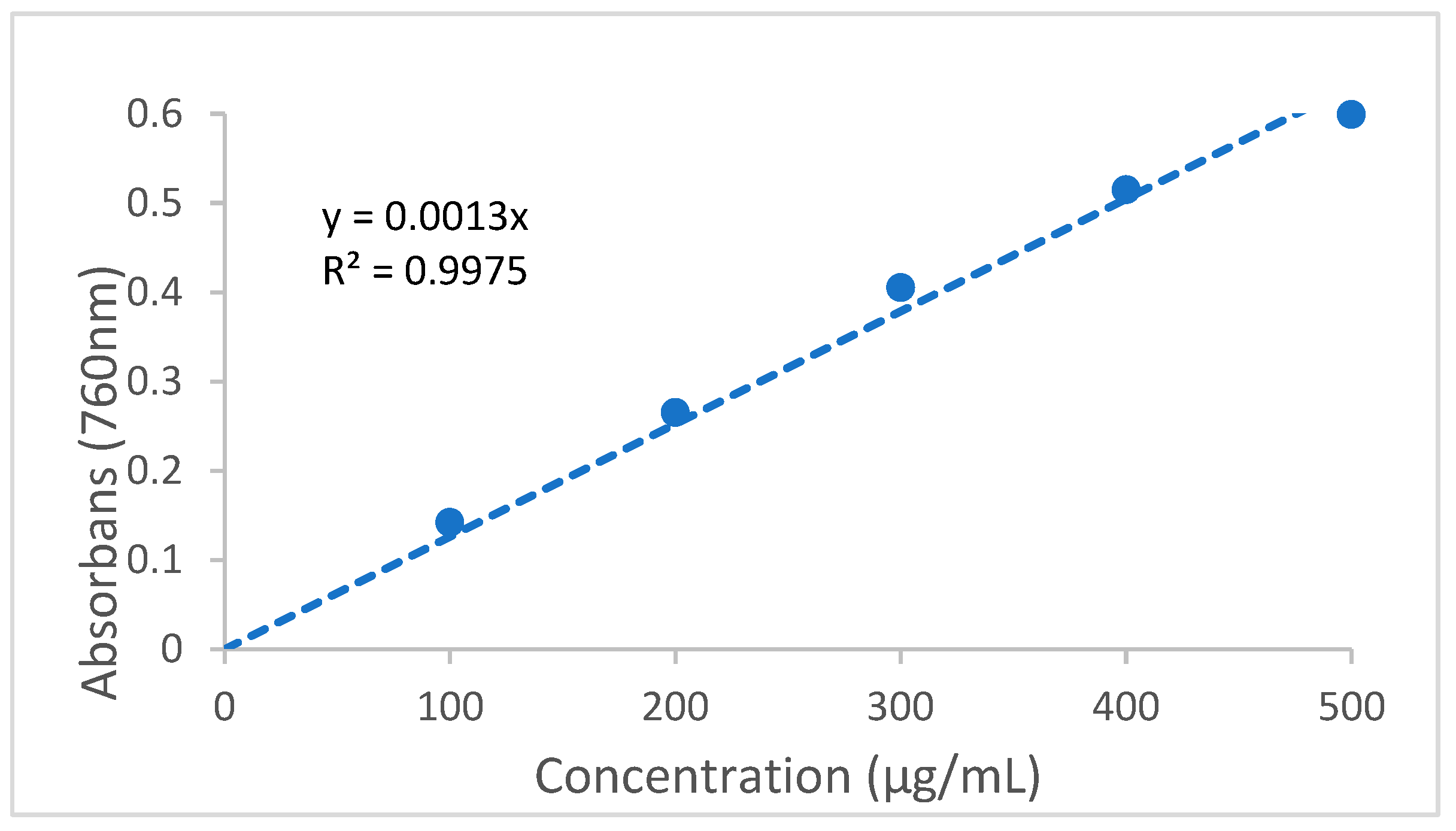
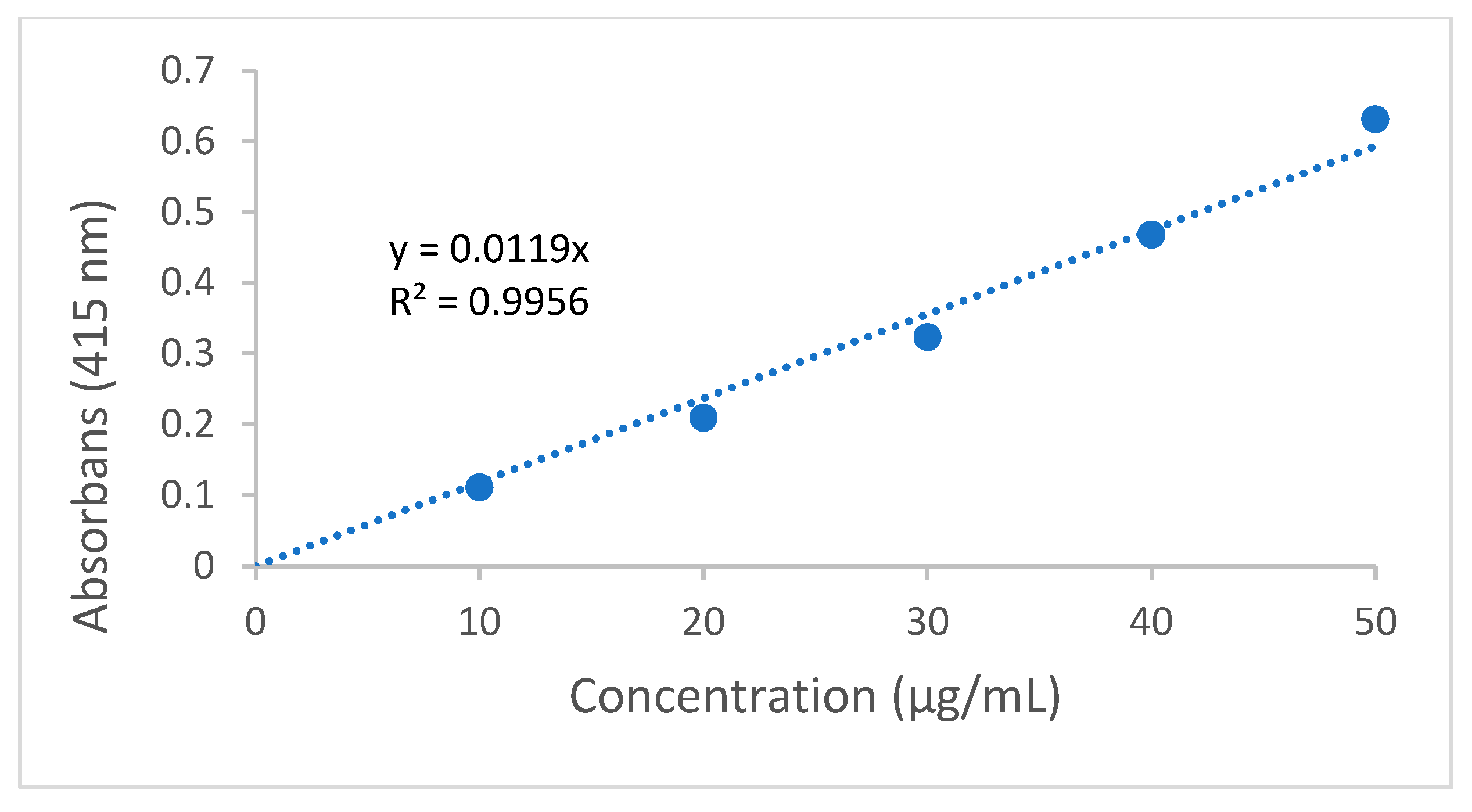
| Element | Linear Range | Correlation Coefficient (r2) | Limit of Detection (LOD) | Limit of Quantification (LOQ) |
|---|---|---|---|---|
| Na | 0–25 (mg/kg) | 0.9992 | 0.029 | 0.088 |
| Mg | 0–25(mg/kg) | 0.9995 | 0.045 | 0.136 |
| Al | 0–25 (mg/kg) | 0.9999 | 0.709 | 2.148 |
| K | 0–25 (mg/kg) | 0.9992 | 0.022 | 0.067 |
| Ca | 0–25 (mg/kg) | 0.9999 | 0.068 | 0.206 |
| V | 0–200 (μg/kg) | 0.9999 | 0.283 | 0.860 |
| Cr | 0–200 (μg/kg) | 0.9999 | 0.190 | 0.576 |
| Mn | 0–10 (mg/kg) | 0.9999 | 0.249 | 0.754 |
| Fe | 0–10 (mg/kg) | 0.9999 | 1.271 | 3.853 |
| Co | 0–200 (μg/kg) | 0.9999 | 0.278 | 0.843 |
| Ni | 0–200 (μg/kg) | 0.9999 | 0.334 | 1.013 |
| Cu | 0–200 (μg/kg) | 0.9997 | 0.621 | 1.883 |
| Zn | 0–10 (mg/kg) | 0.9999 | 0.301 | 0.914 |
| As | 0–200 (μg/kg) | 0.9999 | 0.317 | 0.962 |
| Se | 0–200 (μg/kg) | 0.9999 | 0.121 | 0.377 |
| Ag | 0–200 (μg/kg) | 0.9999 | 0.128 | 0.387 |
| Cd | 0–200 (μg/kg) | 0.9999 | 0.217 | 0.659 |
| Pb | 0–200 (μg/kg) | 0.9999 | 0.725 | 2.197 |
| No | Analyte | Propolis | R.T. | M.I. (m/z) | F.I. (m/z) | r2 | LOD/LOQ (µg/L) |
|---|---|---|---|---|---|---|---|
| 1 | Quinic acid | 4.89 ± 0.18 | 3.0 | 190.8 | 93.0 | 0.996 | 25.7/33.3 |
| 2 | Fumaric aid | - | 3.9 | 115.2 | 40.9 | 0.995 | 135.7/167.9 |
| 3 | Aconitic acid | - | 4.0 | 172.8 | 129.0 | 0.971 | 16.4/31.4 |
| 4 | Gallic acid | 0.03 ± 0.0003 | 4.4 | 168.8 | 79.0 | 0.999 | 13.2/17.0 |
| 5 | Epigallocatechin | - | 6.7 | 304.8 | 219.0 | 0.998 | 237.5/265.9 |
| 6 | Protocatechuic acid | 0.152 ± 0.005 | 6.8 | 152.8 | 108.0 | 0.957 | 21.9/38.6 |
| 7 | Catechin | - | 7.4 | 288.8 | 203.1 | 0.999 | 55.0/78.0 |
| 8 | Gentisic acid | 0.085 ± 0.001 | 8.3 | 152.8 | 109.0 | 0.997 | 18.5/28.2 |
| 9 | Chlorogenic acid | 0.026 ± 0.0005 | 8.4 | 353.0 | 85.0 | 0.995 | 13.1/17.6 |
| 10 | Protocatechuic aldehyde | 0.096 ± 0.003 | 8.5 | 137.2 | 92.0 | 0.996 | 15.4/22.2 |
| 11 | Tannic acid | 0.058 ± 0.001 | 9.2 | 182.8 | 78.0 | 0.999 | 15.3/22.7 |
| 12 | Epigallocatechin gallate | - | 9.4 | 457.0 | 305.1 | 0.999 | 61.0/86.0 |
| 13 | Cynarin | - | 9.8 | 515.0 | 191.0 | 0.999 | 5.8/9.4 |
| 14 | 4-OH Benzoic acid | 0.159 ± 0.003 | 10.5 | 137,2 | 65.0 | 0.999 | 68.4/88.1 |
| 15 | Epicatechin | - | 11.6 | 289.0 | 203.0 | 0.996 | 139.6/161.6 |
| 16 | Vanilic acid | 0.422 ± 0.006 | 11.8 | 166.8 | 108.0 | 0.999 | 141.9/164.9 |
| 17 | Caffeic acid | 1.839 ± 0.027 | 12.1 | 179.0 | 134.0 | 0.999 | 7.7/9.5 |
| 18 | Syringic acid | - | 12.6 | 196.8 | 166.9 | 0.998 | 82.3/104.5 |
| 19 | Vanillin | 0.126 ± 0.001 | 13.9 | 153.1 | 125.0 | 0.996 | 24.5/30.4 |
| 20 | Syringic aldehyde | - | 14.6 | 181.0 | 151.1 | 0.999 | 19.7/28.0 |
| 21 | Daidzin | - | 15.2 | 417.1 | 199.0 | 0.996 | 7.0/9.5 |
| 22 | Epicatechin gallate | - | 15.5 | 441.0 | 289.0 | 0.997 | 19.5/28.5 |
| 23 | Piceid | - | 17.2 | 391.0 | 135/106.9 | 0.999 | 13.8/17.8 |
| 24 | p-Coumaric acid | 2.735 ± 0.053 | 17.8 | 163.0 | 93.0 | 0.999 | 25.9/34.9 |
| 25 | Ferulic acid-D3-IS | N.A. | 18.8 | 196.2 | 152.1 | N.A. | N.A. |
| 26 | Ferulic acid | 4.378 ± 0.079 | 18.8 | 192.8 | 149.0 | 0.999 | 11.8/15.6 |
| 27 | Sinapic acid | - | 18.9 | 222.8 | 193.0 | 0.999 | 65.2/82.3 |
| 28 | Coumarin | 0.019 ± 0.0007 | 20.9 | 146.9 | 103.1 | 0.999 | 214.2/247.3 |
| 29 | Salicylic acid | 0.068 ± 0.001 | 21.8 | 137.2 | 65.0 | 0.999 | 6.0/8.3 |
| 30 | Cyranoside | - | 23.7 | 447.0 | 284.0 | 0.997 | 12.1/16.0 |
| 31 | Miquelianin | 0.015 ± 0.0003 | 24.1 | 477.0 | 150.9 | 0.999 | 10.6/14.7 |
| 32 | Rutin-D3-IS | N.A. | 25.5 | 612.2 | 304.1 | N.A. | N.A. |
| 33 | Rutin | - | 25.6 | 608.9 | 301.0 | 0.999 | 15.7/22.7 |
| 34 | isoquercitrin | 0.108 ± 0.002 | 25.6 | 463.0 | 271.0 | 0.998 | 8.7/13.5 |
| 35 | Hesperidin | 0.121 ± 0.004 | 25.8 | 611.2 | 449.0 | 0.999 | 19.0/26.0 |
| 36 | o-Coumaric acid | - | 26.1 | 162.8 | 93.0 | 0.999 | 31.8/40.4 |
| 37 | Genistin | - | 26.3 | 431.0 | 239.0 | 0.991 | 14.9/21.7 |
| 38 | Rosmarinic acid | - | 26.6 | 359.0 | 197.0 | 0.999 | 16.2/21.2 |
| 39 | Ellagic acid | - | 27.6 | 301.0 | 284.0 | 0.999 | 56.9/71.0 |
| 40 | Cosmosiin | 0.043 ± 0.0003 | 28.2 | 431.0 | 269.0 | 0.998 | 6.3/9.2 |
| 41 | Quercitrin | 0.314 ± 0.008 | 29.8 | 447.0 | 301.0 | 0.999 | 4.8/6.4 |
| 42 | Astragalin | 0.074 ± 0.0008 | 30.4 | 447.0 | 255.0 | 0.999 | 6.6/8.2 |
| 43 | Nicotiflorin | 0.082 ± 0.0008 | 30.6 | 592.9 | 255.0/284.0 | 0.999 | 11.9/16.7 |
| 44 | Fisetin | - | 30.6 | 285.0 | 163.0 | 0.999 | 10.1/12.7 |
| 45 | Daidzein | - | 34.0 | 253.0 | 223.0 | 0.999 | 9.8/11.6 |
| 46 | Quercetin-D3-IS | N.A. | 35.6 | 304.0 | 275.9 | N.A. | N.A. |
| 47 | Quercetin | 0.653 ± 0.011 | 35.7 | 301.0 | 272.9 | 0.999 | 15.5/19.0 |
| 48 | Naringenin | 6.56 ± 0.257 | 35.9 | 270.9 | 119.0 | 0.999 | 2.6/3.9 |
| 49 | Hesperetin | 0.462 ± 0.014 | 36.7 | 301.0 | 136.0/286.0 | 0.999 | 7.1/9.1 |
| 50 | Luteolin | 0.297 ± 0.009 | 36.7 | 284.8 | 151.0/175.0 | 0.999 | 2.6/4.1 |
| 51 | Genistein | - | 36.9 | 269.0 | 135.0 | 0.999 | 3.7/5.3 |
| 52 | Kaempferol | 1.286 ± 0,027 | 37.9 | 285.0 | 239.0 | 0.999 | 10.2/15.4 |
| 53 | Apigenin | 0.939 ± 0,016 | 38.2 | 268.8 | 151.0/149.0 | 0.998 | 1.3/2.0 |
| 54 | Amentoflavone | 0.003 ± 0.0001 | 39.7 | 537.0 | 417.0 | 0.992 | 2.8/5.1 |
| 55 | Chrysin | 3.613 ± 0.116 | 40.5 | 252.8 | 145.0/119.0 | 0.999 | 1.5/2.8 |
| 56 | Acacetin | 23.604 ± 0.856 | 40.7 | 283.0 | 239.0 | 0.997 | 1.5/2.5 |
| Major Phytochemicals in Propolis | |
|---|---|
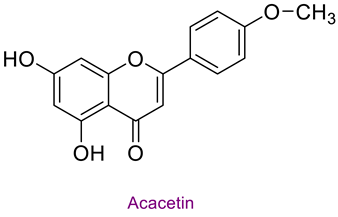 | 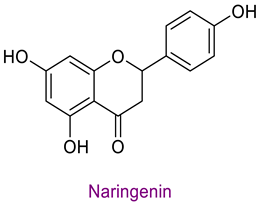 |
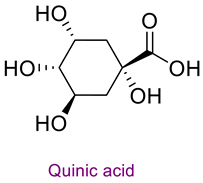 | 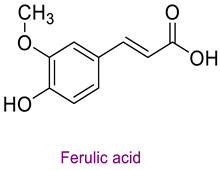 |
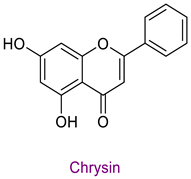 | 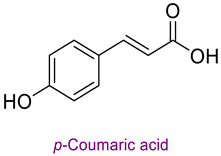 |
 | 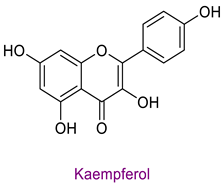 |
| Sample | Na (mg/kg) | Mg (mg/kg) | Al (mg/kg) | K (mg/kg) | Ca (mg/kg) | V (mg/kg) |
| Propolis | 124.3 ± 4.2 | 710.8 ± 13.7 | 1066.2 ± 27.3 | 1521.4 ± 33.1 | 483.7 ± 11.9 | 1.8 ± 0.03 |
| Sample | Cr (mg/kg) | Mn (mg/kg) | Fe (mg/kg) | Co (mg/kg) | Ni (mg/kg) | Cu (mg/kg) |
| Propolis | 2.3 ± 0.05 | 31.7 ± 2.19 | 1068.2 ± 33.5 | 0.6 ± 0.002 | 2.8 ± 0.02 | 2.2 ± 0.03 |
| Sample | Zn (mg/kg) | As (µg/kg) | Ag (µg/kg) | Cd (µg/kg) | Pb (µg/kg) | Se (µg/kg) |
| Propolis | 73.4 ± 2.23 | <LOD | <LOD | 1.1 ± 3.15 | 18.6 ± 0.02 | <LOD |
| Sample | Total Phenolics (mg GAE/g) | Total Flavonoids (mg QE/g) |
|---|---|---|
| Propolis | 215.14 ± 1.19 | 79.11 ± 0.39 |
| Antioxidants and Sample | Fe3+ Reducing | Cu2+ Reducing | Fe3+-TPTZ Reducing | |||
| λ 700 | r2 | λ450 | r2 | λ 593 | r2 | |
| BHA | 2.123 ± 0.020 | 0.9914 | 1.400 ± 0.051 | 0.9472 | 0.942 ± 0.007 | 0.9830 |
| BHT | 1.464 ± 0.014 | 0.9797 | 1.342 ± 0.007 | 0.9775 | 0.799 ± 0.007 | 0.9960 |
| Trolox | 1.270 ± 0.014 | 0.9905 | 0.706 ± 0.017 | 0.9759 | 0.883 ± 0.020 | 0.9895 |
| α-Tocopherol | 1.912 ± 0.084 | 0.9871 | 1.133 ± 0.086 | 0.9885 | 1.113 ± 0.010 | 0.9978 |
| Propolis | 0.940 ± 0.029 | 0.9907 | 1.183 ± 0.041 | 0.9858 | 0.963 ± 0.024 | 0.9759 |
| Antioxidants and Sample | DPPH• Scavenging | ABTS•+ Scavenging | ||
|---|---|---|---|---|
| IC50 | r2 | IC50 | r2 | |
| BHA | 9.900 ± 0.03 | 0.9618 | 4.521 ± 0.03 | 0.9930 |
| BHT | 14.140 ± 0.04 | 0.9935 | 5.812 ± 0.03 | 0.9805 |
| Trolox | 6.026 ± 0.03 | 0.9429 | 4.813 ± 0.02 | 0.9749 |
| α-Tocopherol | 9.240 ± 0.03 | 0.9748 | 7.304 ± 0.03 | 0.9982 |
| Propolis | 16.700 ± 0.09 | 0.9851 | 8.010 ± 0.05 | 0.9806 |
| Sample and Standard | hCA I | hCA II | ||
|---|---|---|---|---|
| IC50 | r2 | IC50 | r2 | |
| Propolis | 13.2 | 0.9799 | 14.5 | 0.9889 |
| Acetazolamide * | 7.19 | 0.9913 | 8.15 | 0.9983 |
| Sample and Standard | α-Glycosidase | AChE | BChE | |||
|---|---|---|---|---|---|---|
| IC50 | r2 | IC50 | r2 | IC50 | r2 | |
| Propolis | 5.72 | 0.9799 | 5.17 | 0.9889 | 7.50 | 0.9895 |
| Acarbose * | 15.95 | 0.9892 | - | - | - | - |
| Tacrine ** | - | - | 8.15 | 0.9983 | 8.15 | 0.9983 |
Disclaimer/Publisher’s Note: The statements, opinions and data contained in all publications are solely those of the individual author(s) and contributor(s) and not of MDPI and/or the editor(s). MDPI and/or the editor(s) disclaim responsibility for any injury to people or property resulting from any ideas, methods, instructions or products referred to in the content. |
© 2024 by the authors. Licensee MDPI, Basel, Switzerland. This article is an open access article distributed under the terms and conditions of the Creative Commons Attribution (CC BY) license (https://creativecommons.org/licenses/by/4.0/).
Share and Cite
İzol, E.; Turhan, M. In-Depth Phytochemical Profile by LC-MS/MS, Mineral Content by ICP-MS, and In-Vitro Antioxidant, Antidiabetic, Antiepilepsy, Anticholinergic, and Antiglaucoma Properties of Bitlis Propolis. Life 2024, 14, 1389. https://doi.org/10.3390/life14111389
İzol E, Turhan M. In-Depth Phytochemical Profile by LC-MS/MS, Mineral Content by ICP-MS, and In-Vitro Antioxidant, Antidiabetic, Antiepilepsy, Anticholinergic, and Antiglaucoma Properties of Bitlis Propolis. Life. 2024; 14(11):1389. https://doi.org/10.3390/life14111389
Chicago/Turabian Styleİzol, Ebubekir, and Münire Turhan. 2024. "In-Depth Phytochemical Profile by LC-MS/MS, Mineral Content by ICP-MS, and In-Vitro Antioxidant, Antidiabetic, Antiepilepsy, Anticholinergic, and Antiglaucoma Properties of Bitlis Propolis" Life 14, no. 11: 1389. https://doi.org/10.3390/life14111389
APA Styleİzol, E., & Turhan, M. (2024). In-Depth Phytochemical Profile by LC-MS/MS, Mineral Content by ICP-MS, and In-Vitro Antioxidant, Antidiabetic, Antiepilepsy, Anticholinergic, and Antiglaucoma Properties of Bitlis Propolis. Life, 14(11), 1389. https://doi.org/10.3390/life14111389






